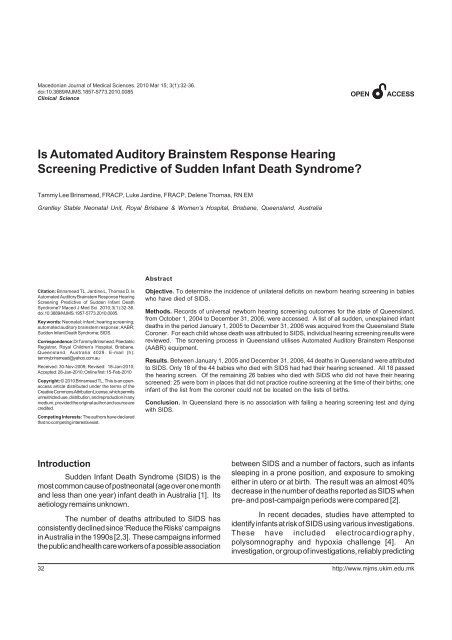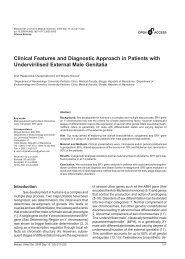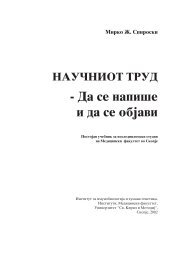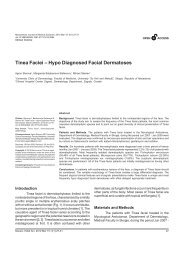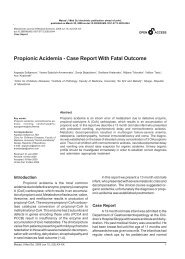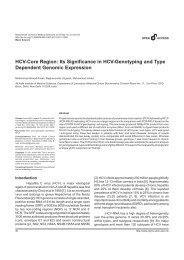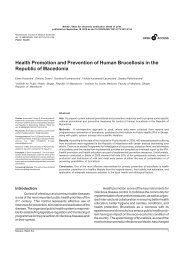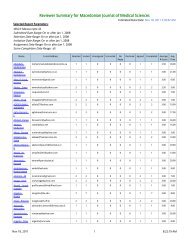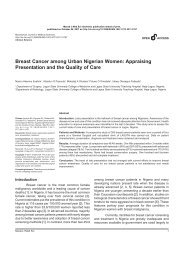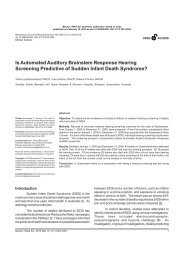Full-Text PDF - Macedonian Journal of Medical Sciences
Full-Text PDF - Macedonian Journal of Medical Sciences
Full-Text PDF - Macedonian Journal of Medical Sciences
Create successful ePaper yourself
Turn your PDF publications into a flip-book with our unique Google optimized e-Paper software.
Clinical Science<br />
<strong>Macedonian</strong> <strong>Journal</strong> <strong>of</strong> <strong>Medical</strong> <strong>Sciences</strong>. 2010 Mar 15; 3(1):32-36.<br />
doi:10.3889/MJMS.1857-5773.2010.0085<br />
Clinical Science<br />
Is Automated Auditory Brainstem Response Hearing<br />
Screening Predictive <strong>of</strong> Sudden Infant Death Syndrome?<br />
Tammy Lee Brinsmead, FRACP, Luke Jardine, FRACP, Delene Thomas, RN EM<br />
Grantley Stable Neonatal Unit, Royal Brisbane & Women’s Hospital, Brisbane, Queensland, Australia<br />
Citation: Brinsmead TL, Jardine L, Thomas D. Is<br />
Automated Auditory Brainstem Response Hearing<br />
Screening Predictive <strong>of</strong> Sudden Infant Death<br />
Syndrome? Maced J Med Sci. 2010;3(1):32-36.<br />
doi.10.3889/MJMS.1957-5773.2010.0085.<br />
Key words: Neonatal; infant; hearing screening;<br />
automated auditory brainstem response; AABR;<br />
Sudden Infant Death Syndrome; SIDS.<br />
Correspondence: Dr Tammy Brinsmead. Paediatric<br />
Registrar, Royal Children’s Hospital, Brisbane,<br />
Queensland, Australia 4029. E-mail (h):<br />
tammybrinsmead@yahoo.com.au<br />
Received: 30-Nov-2009; Revised: 18-Jan-2010;<br />
Accepted: 28-Jan-2010; Online first: 15-Feb-2010<br />
Copyright: © 2010 Brinsmead TL. This is an openaccess<br />
article distributed under the terms <strong>of</strong> the<br />
Creative Commons Attribution License, which permits<br />
unrestricted use, distribution, and reproduction in any<br />
medium, provided the original author and source are<br />
credited.<br />
Competing Interests: The authors have declared<br />
that no competing interests exist.<br />
32<br />
Abstract<br />
Introduction<br />
Sudden Infant Death Syndrome (SIDS) is the<br />
most common cause <strong>of</strong> postneonatal (age over one month<br />
and less than one year) infant death in Australia [1]. Its<br />
aetiology remains unknown.<br />
The number <strong>of</strong> deaths attributed to SIDS has<br />
consistently declined since ‘Reduce the Risks‘ campaigns<br />
in Australia in the 1990s [2,3]. These campaigns informed<br />
the public and health care workers <strong>of</strong> a possible association<br />
OPENACCESS<br />
Objective. To determine the incidence <strong>of</strong> unilateral deficits on newborn hearing screening in babies<br />
who have died <strong>of</strong> SIDS.<br />
Methods. Records <strong>of</strong> universal newborn hearing screening outcomes for the state <strong>of</strong> Queensland,<br />
from October 1, 2004 to December 31, 2006, were accessed. A list <strong>of</strong> all sudden, unexplained infant<br />
deaths in the period January 1, 2005 to December 31, 2006 was acquired from the Queensland State<br />
Coroner. For each child whose death was attributed to SIDS, individual hearing screening results were<br />
reviewed. The screening process in Queensland utilises Automated Auditory Brainstem Response<br />
(AABR) equipment.<br />
Results. Between January 1, 2005 and December 31, 2006, 44 deaths in Queensland were attributed<br />
to SIDS. Only 18 <strong>of</strong> the 44 babies who died with SIDS had had their hearing screened. All 18 passed<br />
the hearing screen. Of the remaining 26 babies who died with SIDS who did not have their hearing<br />
screened: 25 were born in places that did not practice routine screening at the time <strong>of</strong> their births; one<br />
infant <strong>of</strong> the list from the coroner could not be located on the lists <strong>of</strong> births.<br />
Conclusion. In Queensland there is no association with failing a hearing screening test and dying<br />
with SIDS.<br />
between SIDS and a number <strong>of</strong> factors, such as infants<br />
sleeping in a prone position, and exposure to smoking<br />
either in utero or at birth. The result was an almost 40%<br />
decrease in the number <strong>of</strong> deaths reported as SIDS when<br />
pre- and post-campaign periods were compared [2].<br />
In recent decades, studies have attempted to<br />
identify infants at risk <strong>of</strong> SIDS using various investigations.<br />
These have included electrocardiography,<br />
polysomnography and hypoxia challenge [4]. An<br />
investigation, or group <strong>of</strong> investigations, reliably predicting<br />
http://www.mjms.ukim.edu.mk
which infants are at risk <strong>of</strong> dying <strong>of</strong> SIDS has not been<br />
established [4].<br />
A recent report by Rubens et al., 2008 suggested<br />
an association between right sided unilateral hearing<br />
deficits as detected by newborn transient evoked<br />
otoacoustic emissions and the risk <strong>of</strong> SIDS [5]. Sininger<br />
et al., 2006 and Berninger, 2007 have previously reported<br />
larger amplitude waves on the right side on auditory<br />
brainstem response (ABR) testing in normal neonates<br />
[6,7]. An increased venous pressure effect on the right<br />
side causing disruption to the inner ear hair cells is a<br />
proposed mechanism for the unilateral difference [5].<br />
Stimulation <strong>of</strong> the vestibular system is known to cause a<br />
change in the respiratory pattern [8,9]. Vestibular stimulation<br />
can re-establish respiratory effort after apnoea [8-10]. An<br />
abnormality in respiratory control is a proposed mechanism<br />
for SIDS [5]. Inner ear insults can disrupt cochlear and<br />
vestibular function and it is possible that such an injury<br />
may occur in the perinatal period [5].<br />
The transient evoked otoacoustic emission<br />
technique described by Rubens et al [5] uses a small<br />
probe placed in the baby’s ear and the administration <strong>of</strong> a<br />
click stimulus at four frequencies in each ear (1500, 2000,<br />
3000 & 4000 decibels [dB]). A signal/noise ratio (SNR) is<br />
generated for each ear at each frequency. The SNR is the<br />
difference between the hearing measurement in decibels<br />
and the level <strong>of</strong> background noise. To have a pass then the<br />
following conditions need to be met:<br />
1. SNR ≥ 4dB at 2,3 & 4 kilohertz;<br />
2. a click stimulus level between 74 dB and 86 dB;<br />
3. ≥ 50 sweeps <strong>of</strong> stimulus delivery in which the<br />
detected noise floor falls below the s<strong>of</strong>tware’s<br />
predetermined acceptance/rejection level.<br />
The Royal Brisbane and Women’s Hospital has<br />
undertaken a universal newborn screening program<br />
(Healthy Hearing) since October 2004. This has gradually<br />
been established in other Queensland centres, and since<br />
December 2006 has been available to all birthing facilities<br />
in the state.<br />
Australia is a wealthy country, with generally high<br />
standards <strong>of</strong> medical care readily available. Its system <strong>of</strong><br />
government has evolved from liberal democratic tradition,<br />
with influence from British and North American models<br />
[11]. Based on per capita gross domestic product, Australia<br />
ranks among the top twenty nations in the world [11]. Life<br />
expectancy for males and females is seventy-nine and<br />
eighty-four years respectively [11]. Queensland’s<br />
Maced J Med Sci. 2010 Mar 15; 3(1):32-36.<br />
Brinsmead TL. Sudden Infant Death Syndrome<br />
population, which represents 21% <strong>of</strong> Australia’s total, is<br />
estimated at 4.47 million [12]. 92% <strong>of</strong> the Australian<br />
population is Caucasian, Asians consistute 7%, and less<br />
the 1% is made up <strong>of</strong> Aboriginals (indigenous Australians)<br />
and other ethnic groups [13]. It is well known that health<br />
outcomes are consistently poorer in the indigenous<br />
population. Although Australia is an arid environment [14],<br />
88.6% <strong>of</strong> the population reside in urban areas [11], which<br />
are typically clustered around the more moderate, coastal<br />
regions.<br />
The aim <strong>of</strong> this study was to determine the<br />
incidence <strong>of</strong> unilateral deficits on newborn hearing screening<br />
in babies who have died <strong>of</strong> SIDS.<br />
Methods<br />
Records <strong>of</strong> universal newborn hearing screening<br />
outcomes for the state <strong>of</strong> Queensland, from October 2004<br />
to December 2006 inclusive, were accessed. A list <strong>of</strong> all<br />
sudden, unexplained infant deaths in the period January 1,<br />
2005 to December 31, 2006 inclusive was acquired from<br />
the Queensland State Coroner. For each child whose<br />
death was attributed to SIDS, individual hearing screening<br />
results were reviewed if available. To improve the likelihood<br />
<strong>of</strong> identifying hearing screening results on each baby,<br />
searches were conducted under the child’s surname at<br />
the time <strong>of</strong> death, and maternal surname at the time <strong>of</strong><br />
birth.<br />
Hearing screening requires detecting the presence<br />
or absence <strong>of</strong> a response at a preset signal intensity level<br />
for the purpose <strong>of</strong> identifying which infants need further<br />
evaluation. The screening process in Queensland utilises<br />
Automated Auditory Brainstem Response (AABR)<br />
equipment. The goal <strong>of</strong> AABR is to detect the presence or<br />
absence <strong>of</strong> a signal, not estimate its characteristics [5].<br />
The screening equipment used by Queensland Health is<br />
the Natus ALGO 3® and the ALGO 3i® (Natus, San<br />
Carlo). One <strong>of</strong> the unique features <strong>of</strong> the ALGO® response<br />
detection method is the use <strong>of</strong> a binary signal detector.<br />
The equipment automatically records whether the baby<br />
has passed the screen (‘pass result’) or whether a referral<br />
for further screening (‘refer result’) is required. If a baby<br />
receives a ‘refer result’ on either or both ears a second<br />
screen <strong>of</strong> both ears is conducted at a later time to confirm<br />
the result. A ‘refer result’ does not necessarily mean that<br />
the baby has a hearing loss. Some common reasons for<br />
needing a second screen are: the baby was unsettled at<br />
the time <strong>of</strong> the first screen; there was background noise<br />
when the test was carried out and/or; the baby had fluid or<br />
a temporary blockage in their ear after birth. If the baby<br />
33
Clinical Science<br />
receives a ‘refer result’ on either or both ears on the second<br />
screen the baby is referred for diagnostic audiology<br />
assessment.<br />
Statistical tests were done using GraphPad Prism<br />
version 3.02 for Windows (GraphPad S<strong>of</strong>tware, San Diego<br />
California USA, www.graphpad.com). To test for differences<br />
in proportions the Chi-squared test was used.<br />
Ethical approval was sought and granted by the<br />
Executive Director <strong>of</strong> <strong>Medical</strong> Services at the Royal<br />
Brisbane Hospital.<br />
Results<br />
From October 1, 2004 to December 31, 2006<br />
(inclusive), there were 117,029 births in Queensland [15].<br />
Of those, 75,161 births were in hospitals where babies<br />
could have their hearing screened [16]. 74,146 (ie.,<br />
63.36% <strong>of</strong> births and 97.79% <strong>of</strong> those born in hospitals<br />
that screen) <strong>of</strong> these babies actually underwent hearing<br />
screening. 1,015 <strong>of</strong> the 75,161 were not screened: 362<br />
were <strong>of</strong>fered hearing screening but their parents or guardians<br />
declined, the reason the remaining 653 were not screened<br />
is unknown.<br />
Between January 1, 2005 and December 31,<br />
2006, 44 deaths in Queensland were attributed to SIDS<br />
[17]. Only 18 <strong>of</strong> the 44 babies who died with SIDS had had<br />
their hearing screened. All 18 passed the hearing screen.<br />
Of the remaining 26 babies who died with SIDS who did not<br />
have their hearing screened: 25 were born in places that<br />
did not practice routine screening at the time <strong>of</strong> their births<br />
[16]; one infant <strong>of</strong> the list from the coroner could not be<br />
located on the lists <strong>of</strong> births.<br />
The two by two table for failing the hearing screen<br />
by whether they died with SIDS or not is shown in Table<br />
1. The difference in proportions is not statistically significant<br />
(Chi-squared test, P value = 0.49).<br />
Table 1: Number <strong>of</strong> babies who passed hearing screening<br />
vs. failed hearing screening, and number <strong>of</strong> deaths attributed<br />
to Sudden Infant Death Syndrome.<br />
Two-sided Chi-squared test, P value = 0.4878.<br />
34<br />
Discussion<br />
None <strong>of</strong> the babies who died with SIDS failed to<br />
pass a hearing screening test and no baby that failed to<br />
pass a hearing screen died with SIDS. Therefore, using<br />
Queensland data, we have shown that there is no<br />
association with failing a hearing screening test and dying<br />
with SIDS. We have therefore failed to confirm the findings<br />
<strong>of</strong> Rubens et al., 2008 [5].<br />
This must be interpreted in context, however. The<br />
number <strong>of</strong> children who died with SIDS in our study was<br />
very small. In addition, only 41% <strong>of</strong> these deaths were in<br />
babies who had hearing screening, reducing the power <strong>of</strong><br />
our study significantly.<br />
There are important differences between how<br />
Rubens et al screened hearing and our screening method.<br />
Otoacoustic emissions, as used in Rubens et al’s study<br />
[5] are obtained from the ear canal by using a sensitive<br />
microphone within a probe assembly that records cochlear<br />
responses to acoustic stimuli [18]. Thus, otoacoustic<br />
emissions reflect the status <strong>of</strong> the peripheral auditory<br />
system extending to the cochlear outer hair cells. In<br />
contrast, auditory brainstem response measurements are<br />
obtained from surface electrodes that record neural activity<br />
generated in the cochlea, auditory nerve, and brainstem in<br />
response to acoustic stimuli delivered via an earphone<br />
[18]. Automated auditory brainstem response<br />
measurements reflect the status <strong>of</strong> the peripheral auditory<br />
system, the eighth nerve, and the brainstem auditory<br />
pathway. Both otoacoustic emission and auditory brainstem<br />
response screening technologies can be used to detect<br />
sensory (cochlear) hearing loss; however, both<br />
technologies may be affected by outer or middle-ear<br />
dysfunction. Consequently, transient conditions <strong>of</strong> the<br />
outer and middle ear may result in a “failed” screening-test<br />
result in the presence <strong>of</strong> normal cochlear and/or neural<br />
function. Moreover, because otoacoustic emissions are<br />
generated within the cochlea, otoacoustic emissions<br />
technology cannot be used to detect neural (eighth nerve<br />
or auditory brainstem pathway) dysfunction. Thus, neural<br />
conduction disorders or auditory neuropathy/dyssynchrony<br />
without concomitant sensory dysfunction will not be<br />
detected by otoacoustic emissions testing [18].<br />
It is not uncommon for a newborn to fail hearing<br />
screens <strong>of</strong> this nature in the neonatal period. In an Italian<br />
study <strong>of</strong> 32,502 newborns in 13 regional birth centres,<br />
1.05% had an abnormal otoacoustic emissions result<br />
(156 children unilaterally, 179 bilaterally). Of those,<br />
however, 82.37% had a normal auditory brainstem response<br />
result [19]. Similarly, a Swedish study <strong>of</strong> 14,287 newborns<br />
http://www.mjms.ukim.edu.mk
at two maternity wards noted 1.35% <strong>of</strong> babies had a<br />
unilateral abnormality on otoacoustic emissions after two<br />
tests [20]. Families participating in neonatal hearing<br />
screening should be prepared for the possibility <strong>of</strong> false<br />
positives, and should be supported during the potentially<br />
anxious waiting period between screening and more<br />
definitive investigation.<br />
It is encouraging to note the high percentage <strong>of</strong><br />
Queensland babies undergoing neonatal hearing screening<br />
tests. One <strong>of</strong> the limitations <strong>of</strong> this study, however, is that<br />
not all children identified as dying from SIDS in the time<br />
frame reviewed had hearing screening at birth.<br />
Our list <strong>of</strong> deaths attributed to SIDS is also likely<br />
to be incomplete. We were unable to account for children<br />
born in Queensland who may have died from SIDS interstate<br />
and internationally.<br />
It is interesting to note that a post hoc analysis <strong>of</strong><br />
our data suggests a baby that does not have hearing<br />
screening is more likely to die <strong>of</strong> SIDS than a baby who has<br />
hearing screening – see Table 2. This association would<br />
need further exploration to draw any conclusions. It would<br />
be useful to establish if this trend has continued now that<br />
screening is universally available in Queensland.<br />
Table 2: Post hoc analysis <strong>of</strong> hearing screening vs no<br />
hearing screening and deaths attributed to Sudden Infant<br />
Death Syndrome.<br />
Two-sided Chi-squared test, P value = 0.0033.<br />
SIDS will always be a difficult area to research. It<br />
probably encompasses a range <strong>of</strong> causes, and once it<br />
occurs, further study is limited by the loss <strong>of</strong> the child’s<br />
life. Most observations must be made retrospectively.<br />
Critics caution that Rubens’ study [5] was<br />
retrospective, the number <strong>of</strong> SIDS cases small, and<br />
cochlear function was used as an unproven representative<br />
<strong>of</strong> vestibular function [21]. There is also a lack <strong>of</strong> clarity in<br />
the paper’s definition <strong>of</strong> SIDS, a common problem in this<br />
area <strong>of</strong> research [21]. In addition, the paper’s methods are<br />
controversial. Its use <strong>of</strong> matched controls, as compared<br />
to independent samples testing, makes it much more<br />
Maced J Med Sci. 2010 Mar 15; 3(1):32-36.<br />
vulnerable to a Type I error [22].<br />
Brinsmead TL. Sudden Infant Death Syndrome<br />
SIDS remains a complex and socially relevant<br />
area <strong>of</strong> study. There are vast opportunities for research,<br />
but the results must be filtered to the public with sensitivity<br />
and a sense <strong>of</strong> perspective. We would be wise to heed the<br />
advice <strong>of</strong> Krous and Byard, and Hamill and Lim. Highlighting<br />
the limitations <strong>of</strong> Rubens’ study, they remind us to protect<br />
families from misinterpreting its implications. First, we<br />
must prevent a sense <strong>of</strong> false reassurance in families with<br />
normal hearing screening results. An emphasis should<br />
remain on the principles <strong>of</strong> the Back to Sleep Campaign,<br />
the evidence for which is more reliable [21]. At the same<br />
time, we must prevent families being falsely alarmed if<br />
their baby fails a neonatal hearing screen [22]. The<br />
difference between the hearing results <strong>of</strong> those in Rubens’<br />
study who did, and did not, die <strong>of</strong> SIDS are subtle. This<br />
has further implications for anxiety in the context <strong>of</strong> an<br />
abnormal hearing screening test. In order to detect a<br />
majority (95%) <strong>of</strong> babies at risk <strong>of</strong> SIDS, an enormous<br />
number <strong>of</strong> false positives would occur (specifically, 87% <strong>of</strong><br />
normal infants) if Rubens’ predictions are accurate [22].<br />
The fact that we found no association between<br />
failed hearing screening and SIDS, and given that in<br />
Queensland we use auditory brainstem response to screen<br />
hearing, means that Rubens et al’s results have little<br />
bearing or relevance in our population. Further study,<br />
involving a much larger number <strong>of</strong> subjects (particularly<br />
those dying with SIDS), is necessary to confirm the<br />
validity <strong>of</strong> this study’s findings.<br />
Conclusions<br />
This limited study suggests that in Queensland<br />
there is no association between failing a hearing screening<br />
test and dying with SIDS. Of the babies who died <strong>of</strong> SIDS<br />
between January 1, 2005 and January 2007, hearing<br />
screening was not predictive.<br />
References<br />
1. Australian Bureau <strong>of</strong> Statistics. SIDS in Australia 1981-<br />
2000 A Statistical Overview. 2003, August. p1. Accessed<br />
online (31/3/08). http://www.sidsandkids.org/researchstatistics.html<br />
2. Tursan d’Espaignet E, Bulsara M, Wolfenden L, Byard<br />
RW, Stanley FJ. Trends in sudden infant death syndrome in<br />
Australia from 1980 to 2002. Forensic Sci Med Pathol.<br />
2008;4(2):83-90. doi:10.1007/s12024-007-9011-y<br />
PMID:19291477.<br />
35
Clinical Science<br />
3. 3303.0 Causes <strong>of</strong> Death, Australia, 2006. pp 35-6.<br />
4. Bentele KH, Albani M. Are there tests predictive for<br />
prolonged apnoea and SIDS? A review <strong>of</strong> epidemiological<br />
and functional studies. Acta Paediatr Scand Suppl.<br />
1988;342:1-21. doi:10.1111/j.1651-2227.1988.tb10792.x<br />
PMID:3291551.<br />
5. Rubens DD, Vohr BR, Tucker R, O'Neil CA, Chung W.<br />
Newborn oto-acoustic emission hearing screening tests:<br />
preliminary evidence for a marker <strong>of</strong> susceptibility to SIDS.<br />
Early Hum Dev. 2008;84(4):225-9. doi:10.1016/<br />
j.earlhumdev.2007.06.001 PMID:17614220.<br />
6. Sininger YS, Cone-Wesson B. Lateral asymmetry in the<br />
ABR <strong>of</strong> neonates: evidence and mechanisms. Hear Res.<br />
2006;212(1-2):203-11. doi:10.1016/j.heares.2005.12.003<br />
PMID:16439078.<br />
7. Berninger E. Characteristics <strong>of</strong> normal newborn transientevoked<br />
otoacoustic emissions: ear asymmetries and sex<br />
effects. Int J Audiol. 2007;46(11):661-9. doi:10.1080/<br />
14992020701438797 PMID:17978948.<br />
8. Siniaia MS, Miller AD. Vestibular effects on upper airway<br />
musculature. Brain Research. 1996;736(1-2):160-4.<br />
doi:10.1016/0006-8993(96)00674-9 PMID:8930320.<br />
9. Mori RL, Bergsman AE, Holmes MJ, Yates BJ. Role <strong>of</strong> the<br />
medial medullary reticular formation in relaying vestibular<br />
signals to the diaphragm and abdominal muscles. Brain<br />
Research. 2001;902(1):82-91. doi:10.1016/S0006-<br />
8993(01)02370-8 PMID:11376597.<br />
10. Farrimond T. Sudden infant death syndrome and<br />
possible relation to vestibular function. Percept Mot Skills.<br />
1990;71(2):419-23. PMID:2251079.<br />
11. http://www.wpro.who.int/countries/2009/aus/ - accessed<br />
13 th January, 2010.<br />
12. http://www.oesr.gov.au – accessed 17 th January, 2010.<br />
36<br />
13. CIA World Factbook. http://www.indexmundi.com/<br />
australia/ethnic_groups.html - accessed 17th January, 2010.<br />
14. http://www.bom.gov.au/lam/climate/levelthree/ausclim/<br />
ausclim.htm - accessed 17th January, 2010.<br />
15. Personal correspondence from the Department <strong>of</strong> Public<br />
Affairs, Queensland State Office.<br />
16. Queensland Health, Healthy Hearing Program Hospital<br />
Databases. Electronic record <strong>of</strong> universal newborn hearing<br />
screening outcomes in Queensland, public and private<br />
birthing facilities.<br />
17. Personal correspondence from the Queensland Office<br />
<strong>of</strong> the State Coroner.<br />
18. Hearing JCoI. Year 2007 Position Statement: Principles<br />
and Guidelines for Early Hearing Detection and Intervention<br />
Programs. Pediatrics. 2007;120:898-921. doi:10.1542/<br />
peds.2007-2333 PMID:17908777.<br />
19. Calevo MG, Mezzano P, Zullino E, Padovani P, Serra G,<br />
STERN Group. Ligurian experience on neonatal hearing<br />
screening: clinical and epidemiological aspects. Acta<br />
Paediatr. 2007;96(11):1592-9. doi:10.1111/j.1651-<br />
2227.2007.00475.x PMID:17937684.<br />
20. Hergils L. Analysis <strong>of</strong> measurements from the first<br />
Swedish universal neonatal hearing screening program.<br />
Int J Audiol. 2007;46(11):680-5. doi:10.1080/<br />
14992020701459868 PMID:17978950.<br />
21. Krous HF, Byard RW. Newborn hearing screens and<br />
SIDS. Early Hum Dev. 2008;84(6):371. doi:10.1016/<br />
j.earlhumdev.2007.10.003 PMID:17996406.<br />
22. Hamill T, Lim G. Otoacoustic emissions does not<br />
currently have ability to detect SIDS. Early Hum Dev.<br />
2008;84(6):373. doi:10.1016/j.earlhumdev.2007.10.004<br />
PMID:18096330.<br />
http://www.mjms.ukim.edu.mk


